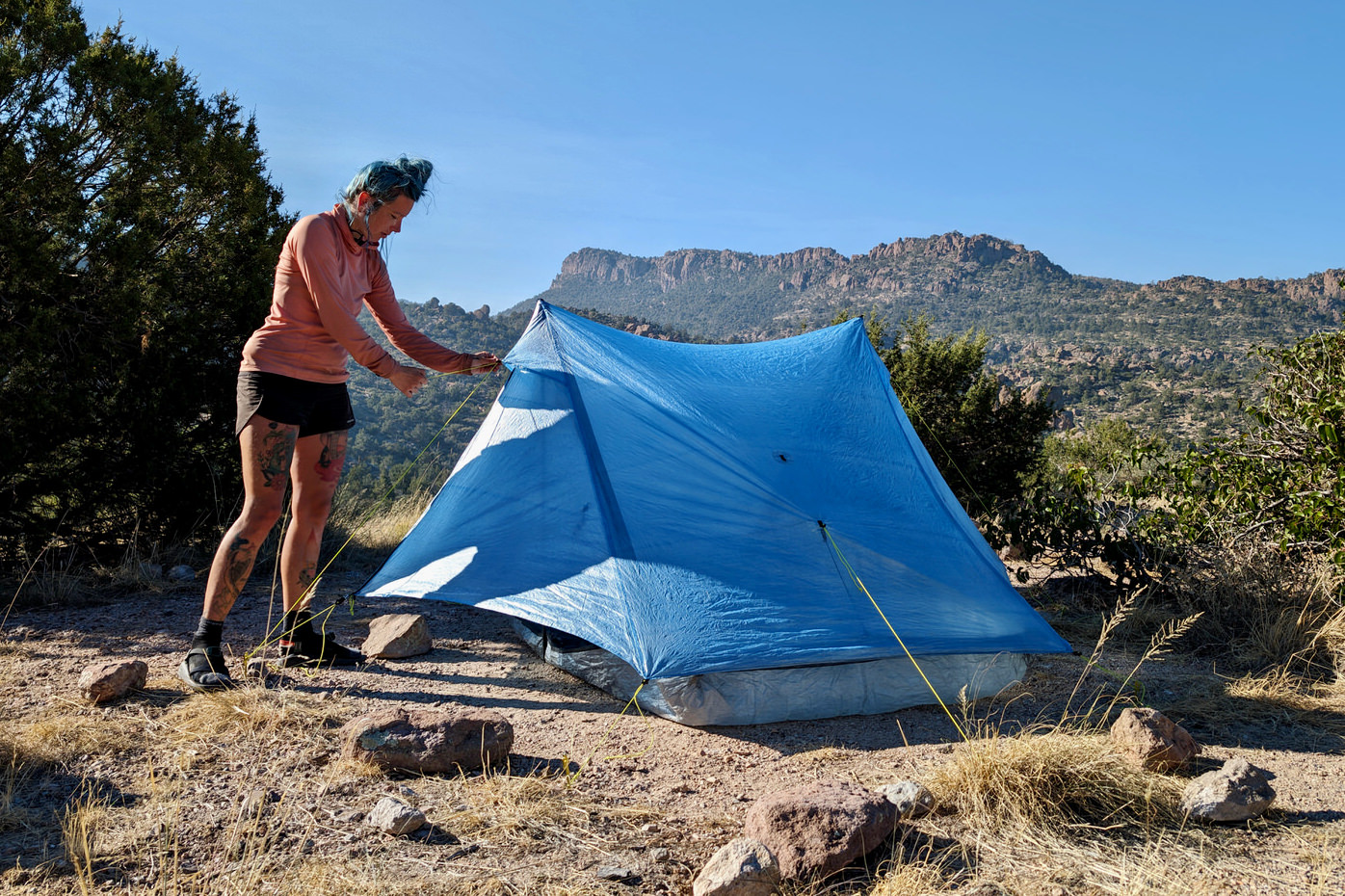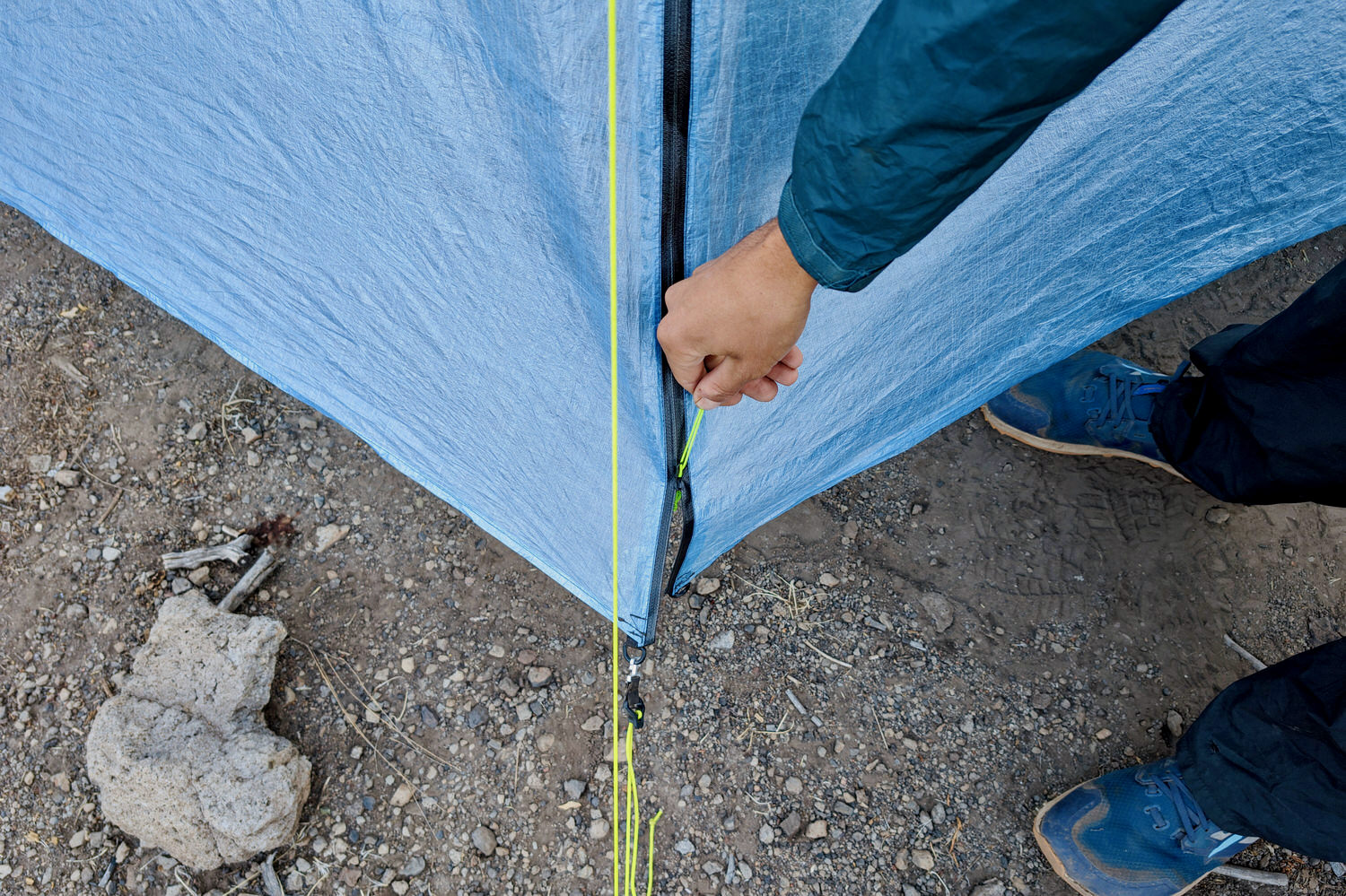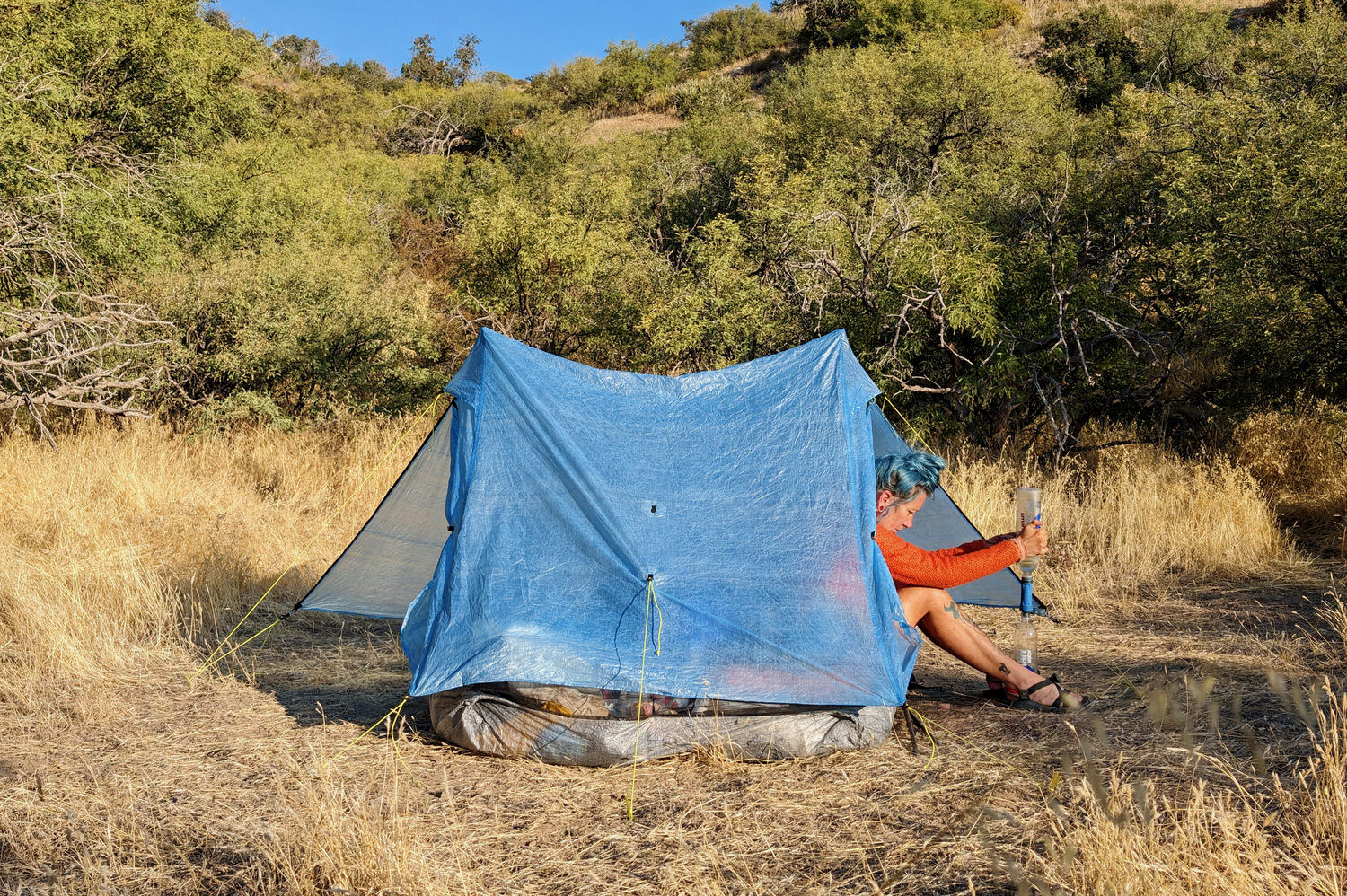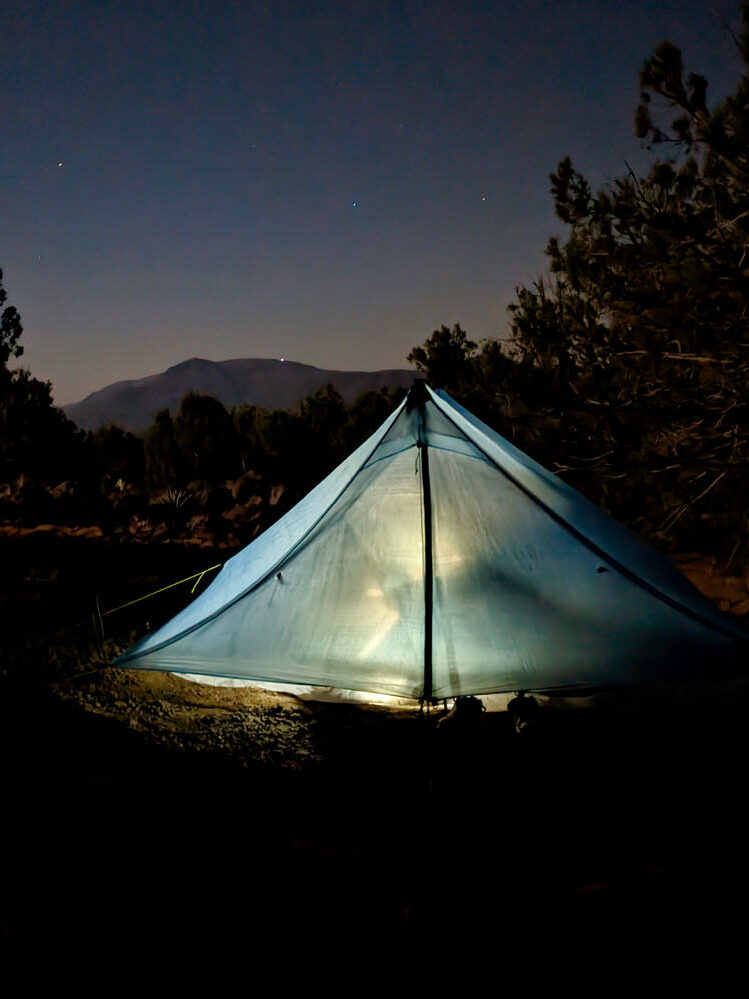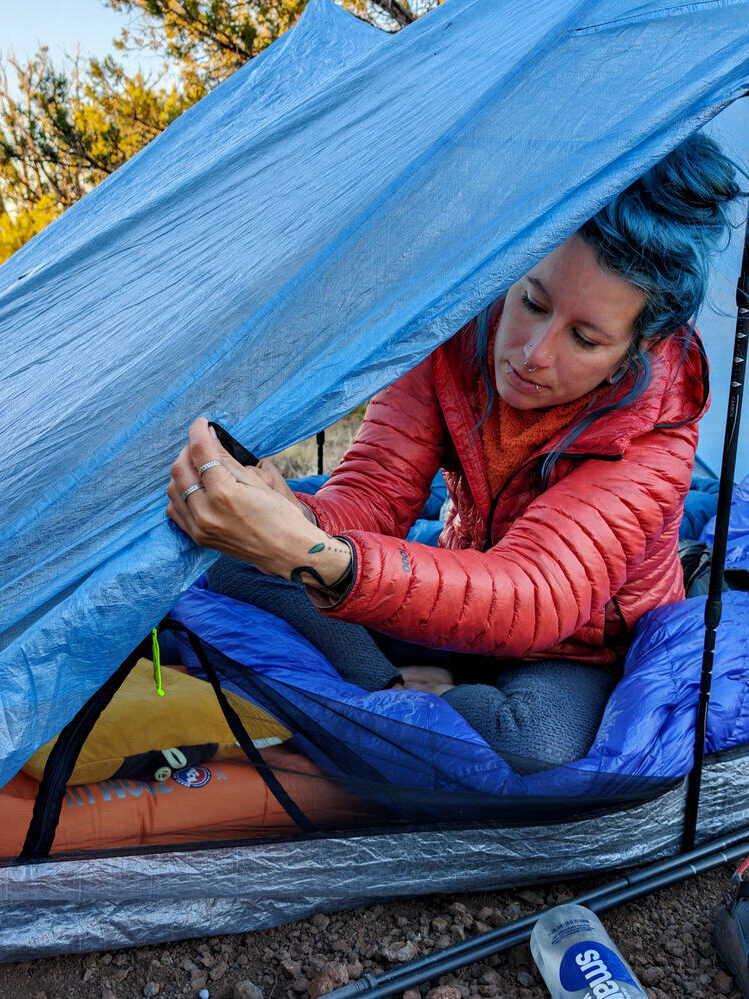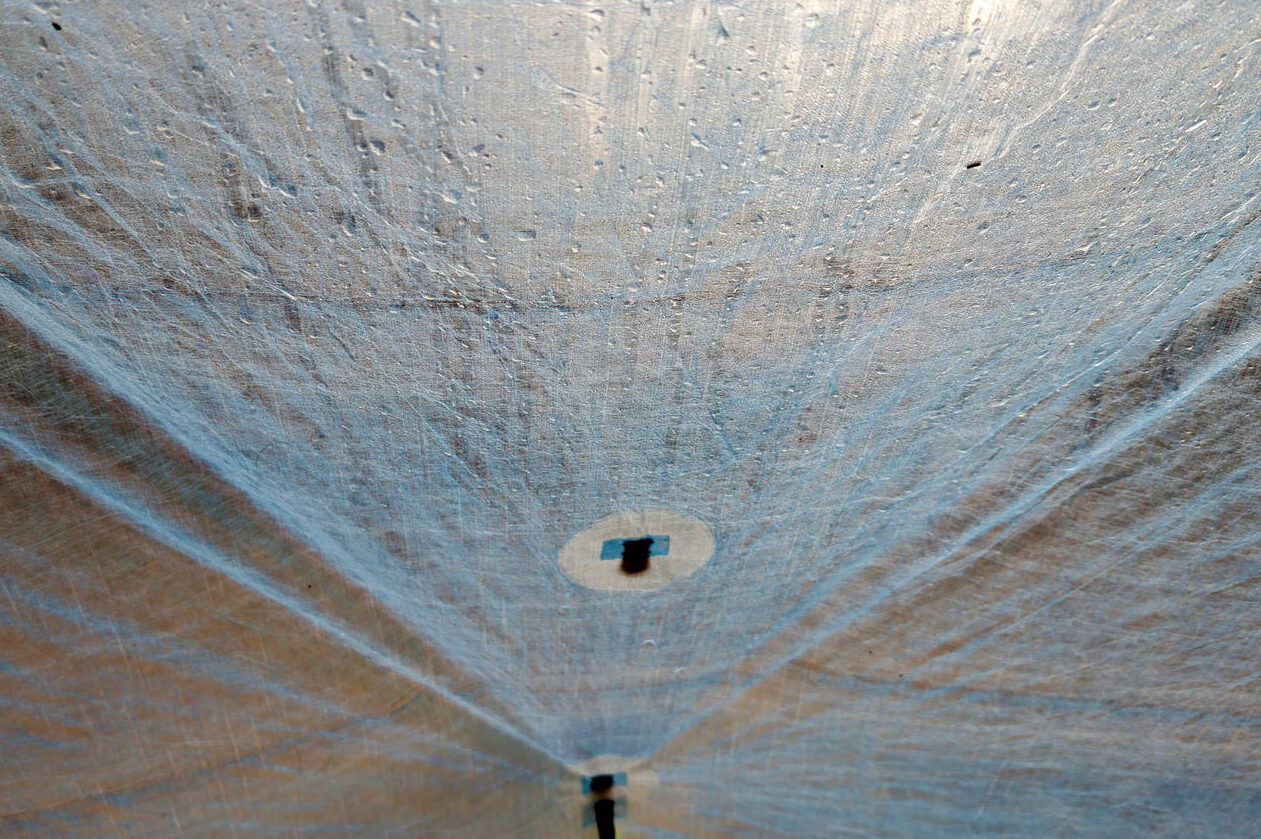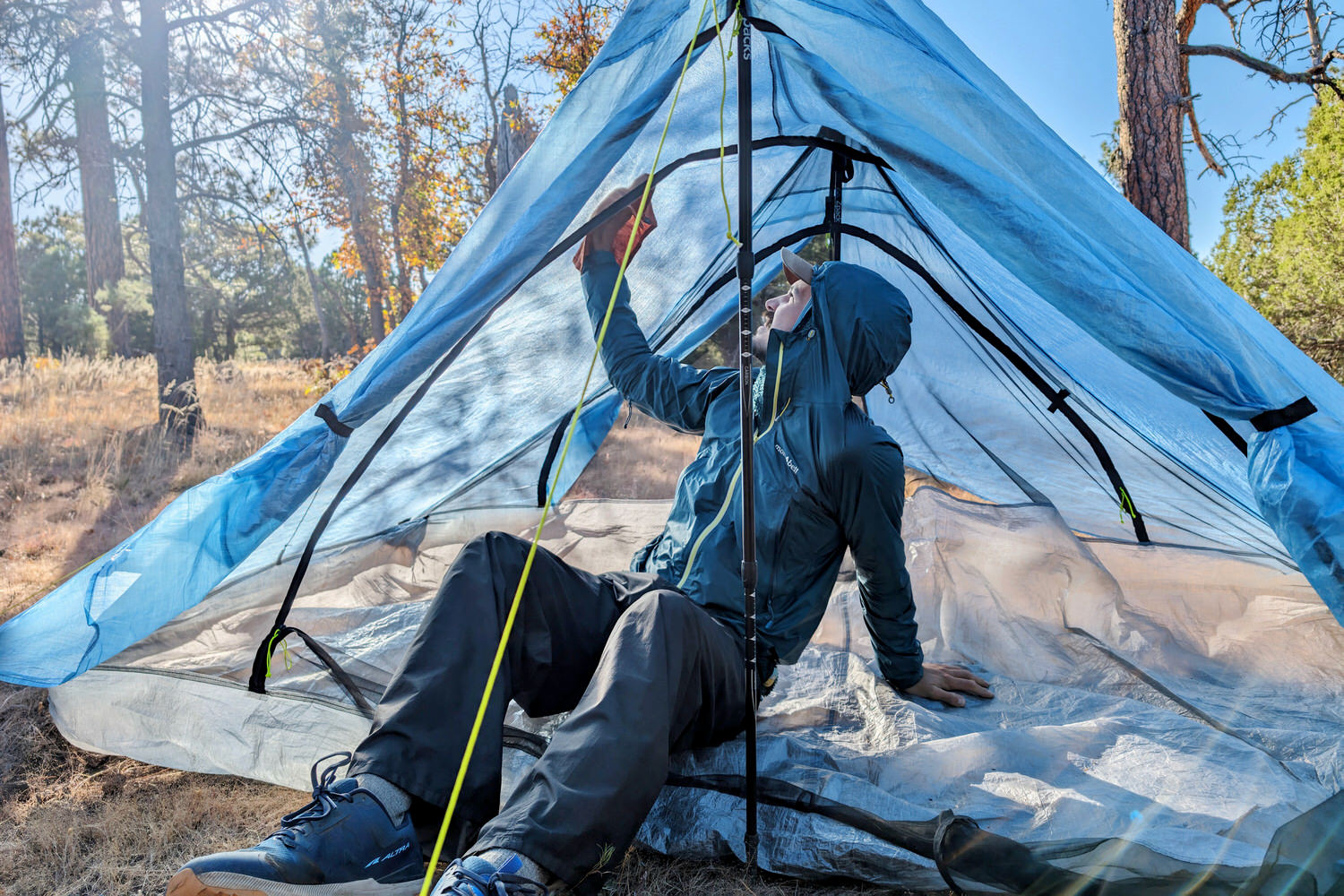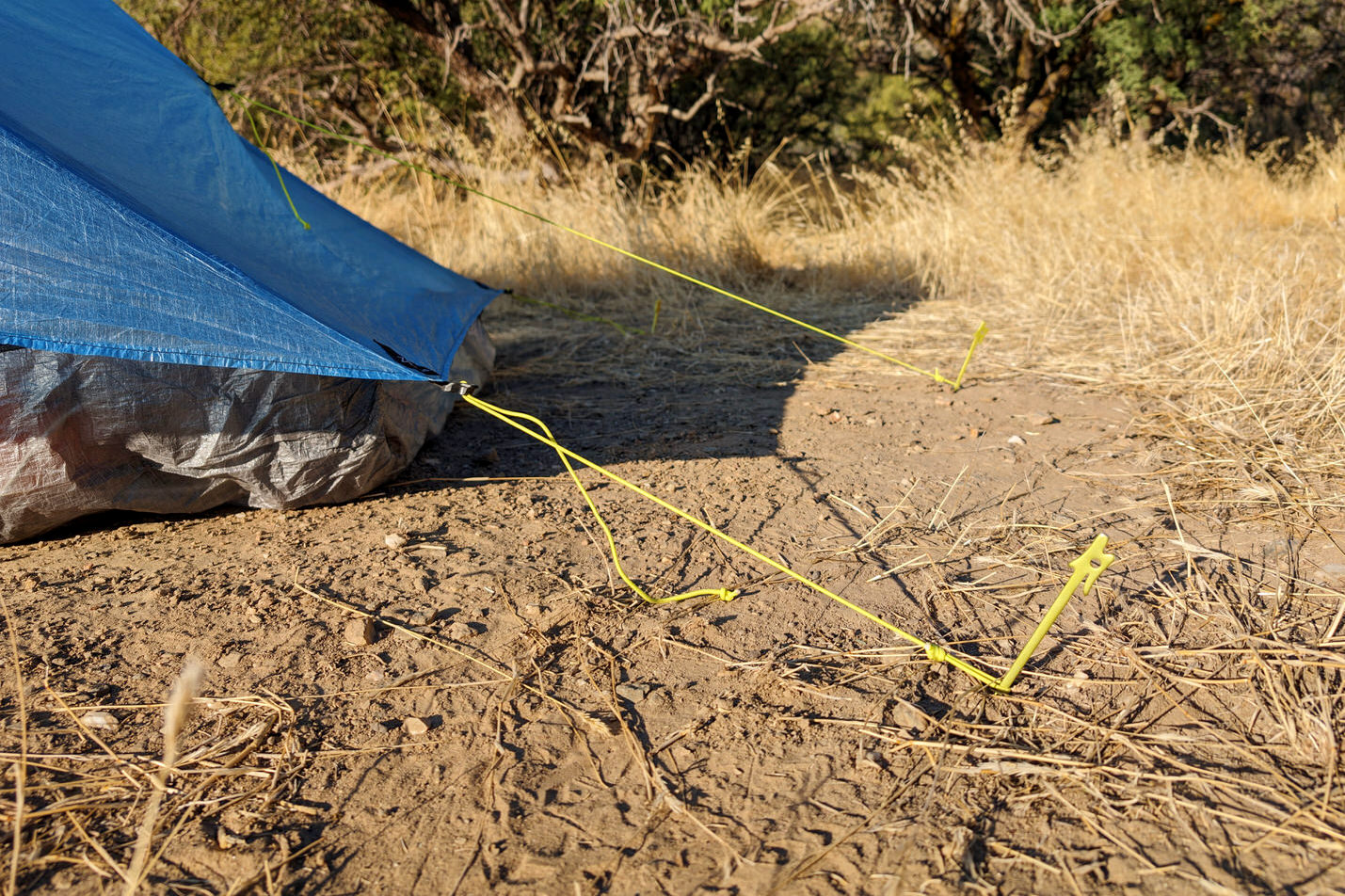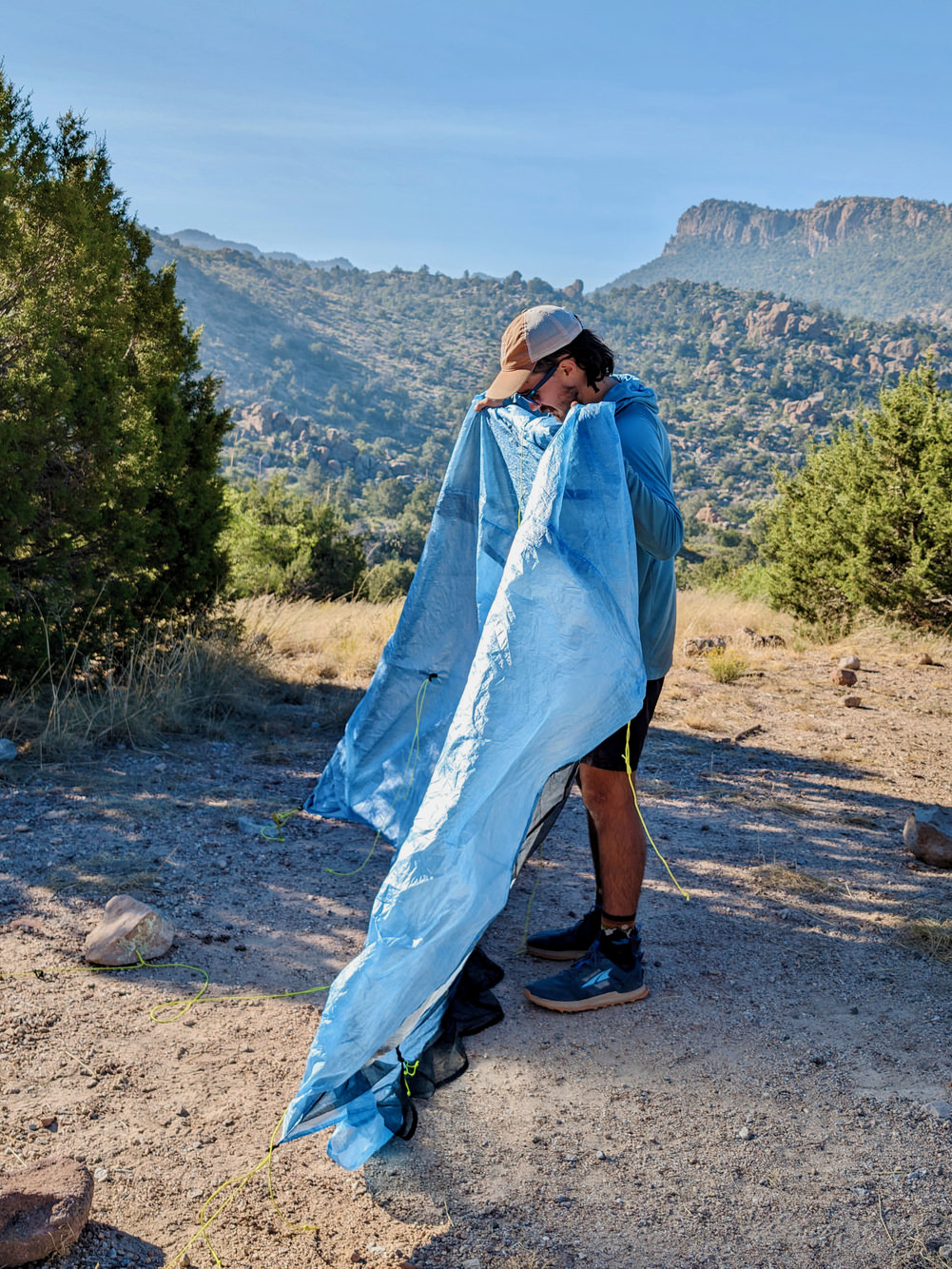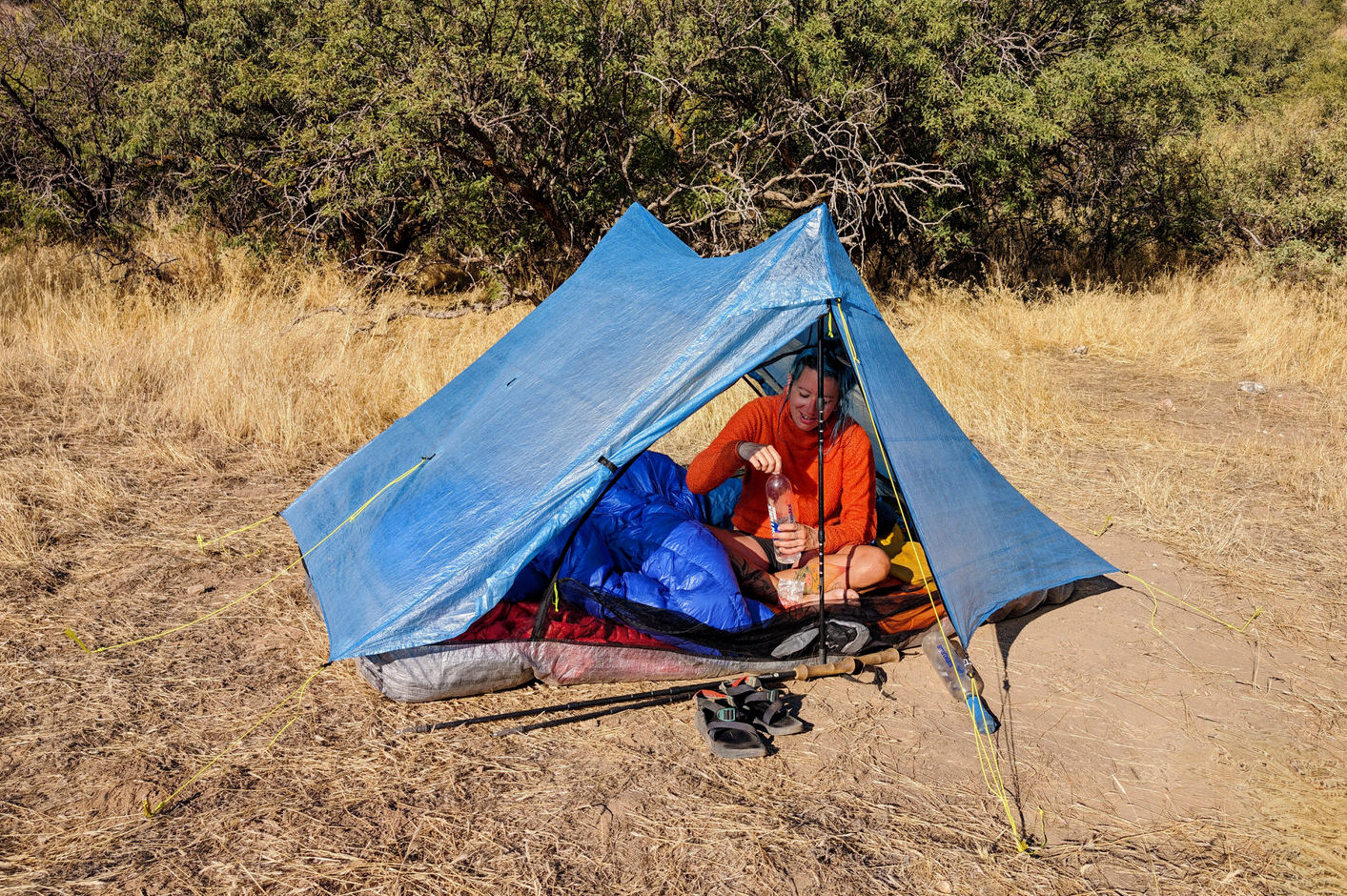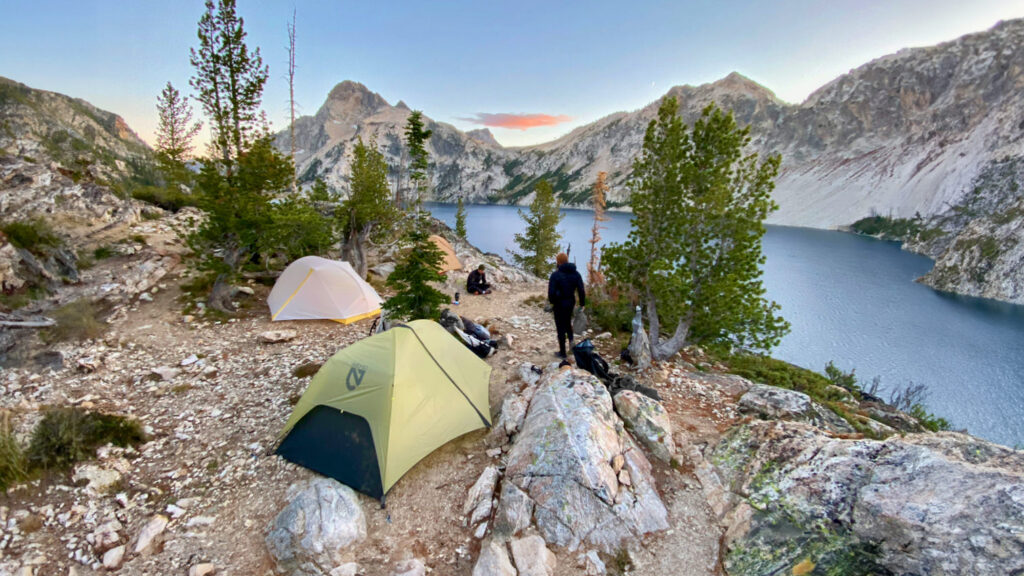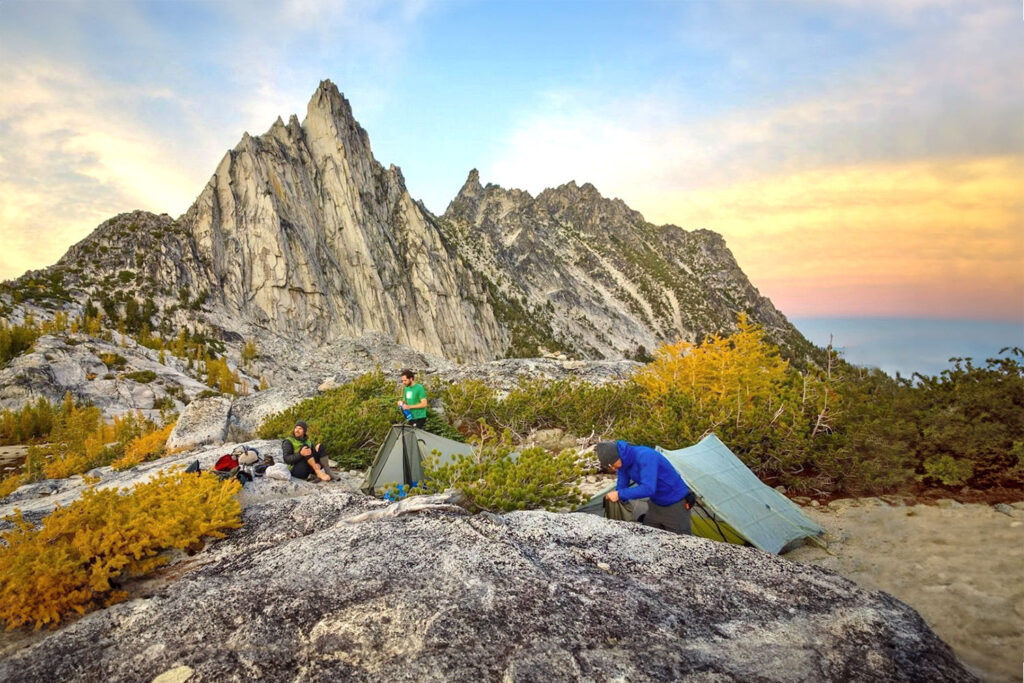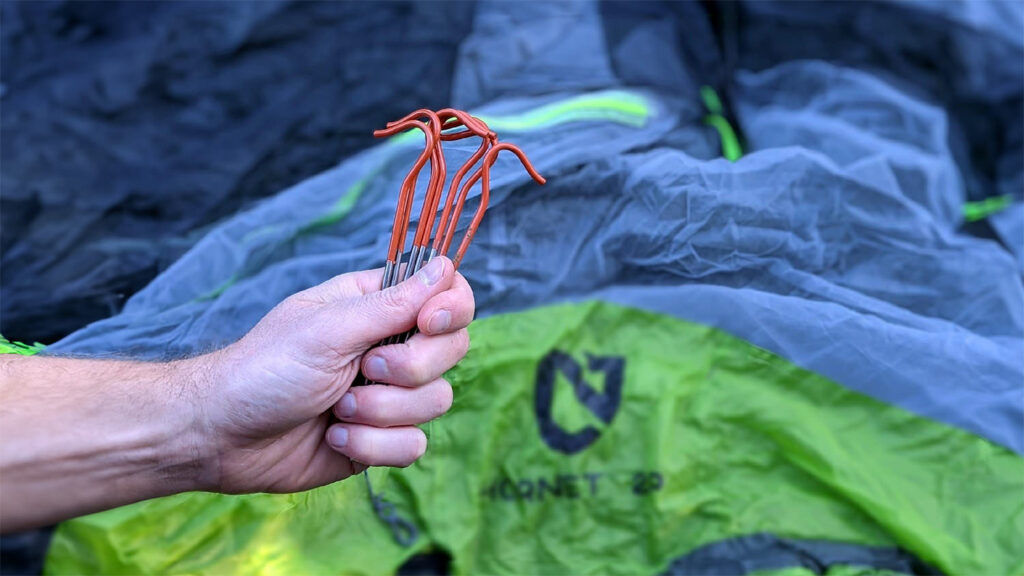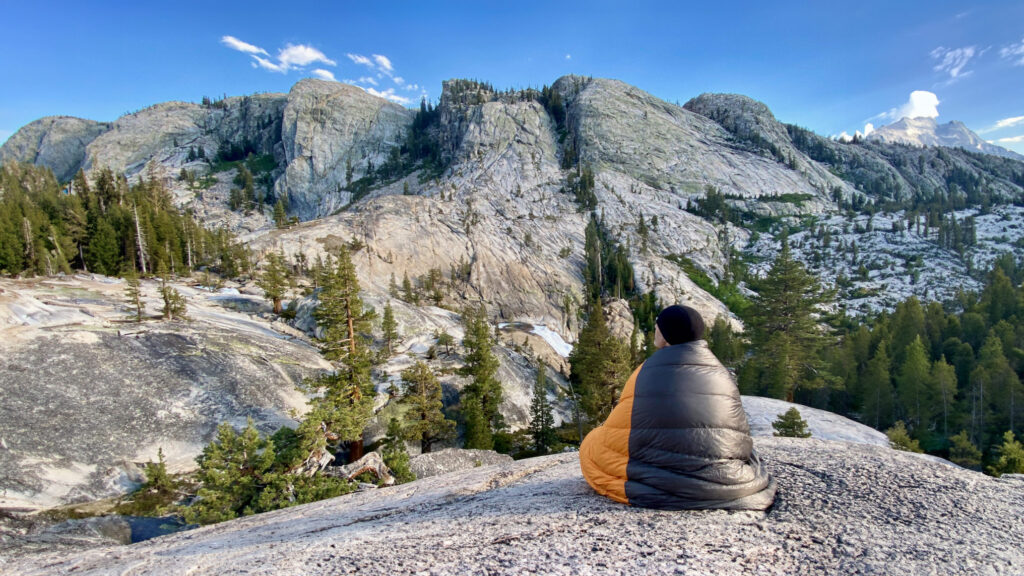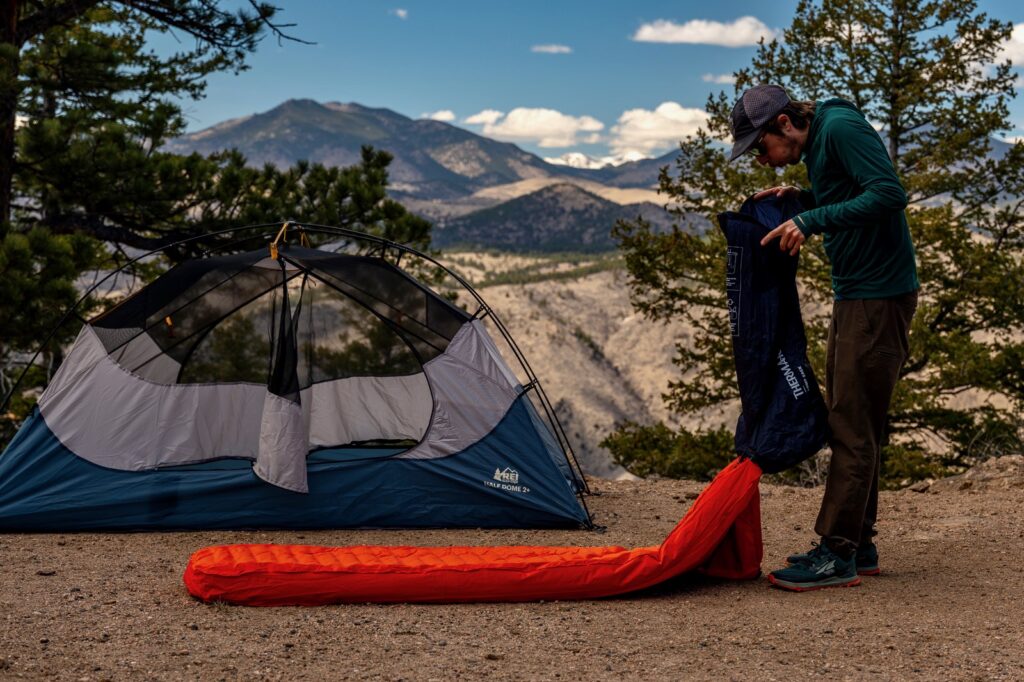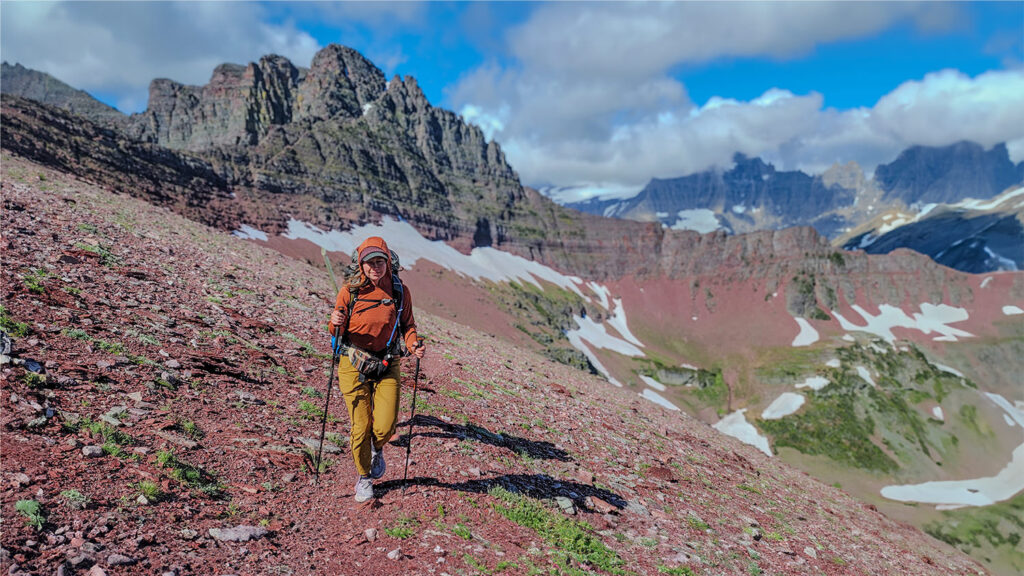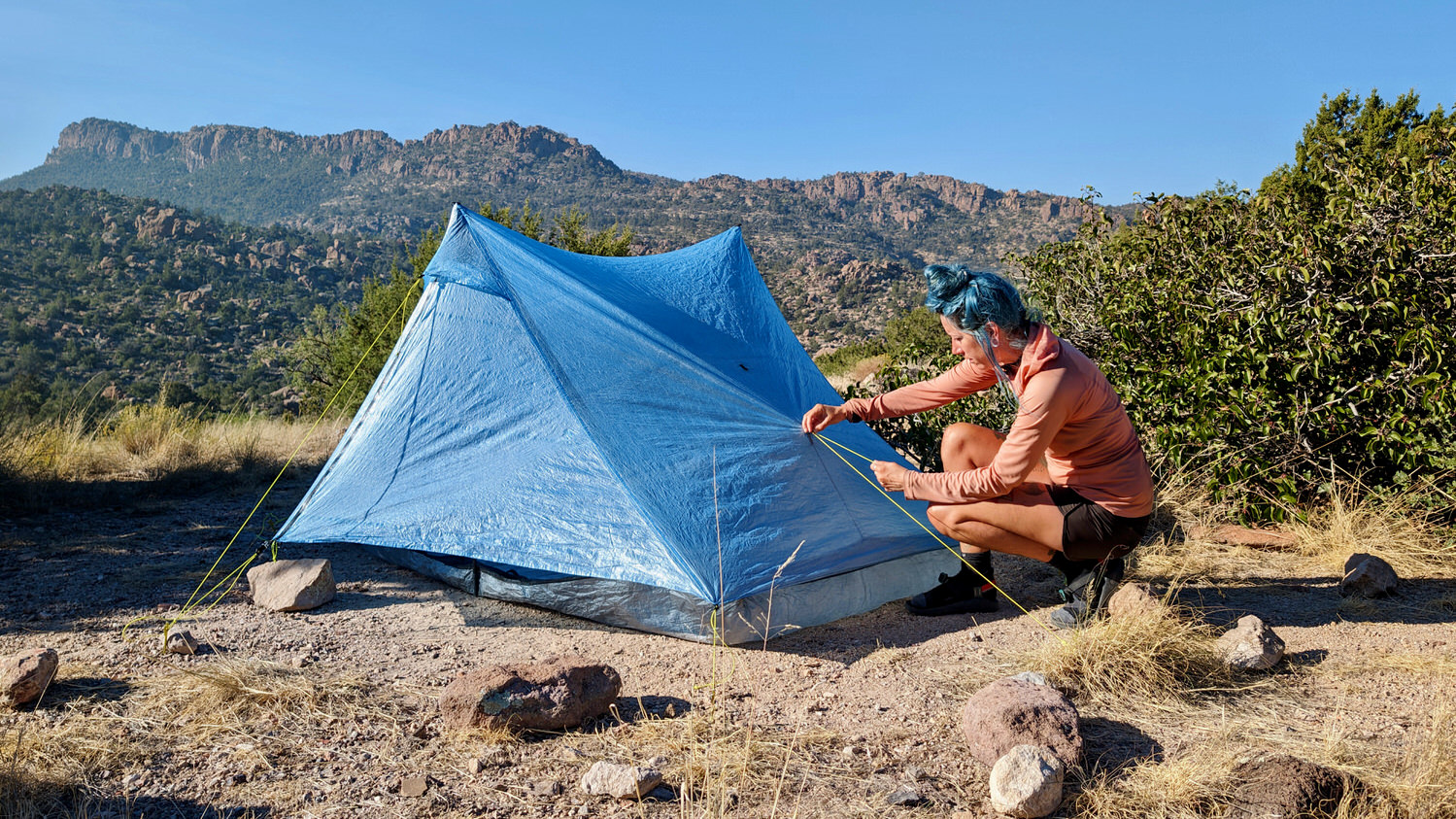
Bottom LIne
The Zpacks Duplex Zip is an update on the Duplex Classic Tent, which is one of our all-time favorite ultralight tents. It blends impressive durability with simple livability and is now available with external waterproof zippers. Gear Analyst Casey Handley tested the new Zip model on her 800-mile, months-long thru-hike of the Arizona Trail, where it proved spacious, durable, and easy to pitch. But this tent is a winner beyond the desert: by swapping out the unique rainfly clips for waterproof zippers, this version of the Duplex performs exceptionally well in wet and stormy conditions. But, it retains the same lightweight design, small packed size, and minimalist features that made the original version so great for backpackers.
However, the Duplex Zip’s non-freestanding structure can be challenging to pitch on rocky ground. And, like all single-wall tents, interior condensation can be an issue in cold and wet weather. The DCF material isn’t the most durable compared to heavy-duty tent fabrics. Additionally, this model is among the most expensive two-person shelters on the market. But if you’re a serious backpacker taking on huge miles and you want some extra protection for seriously stormy weather, the Zpacks Duplex Zip is an excellent choice.
Quick Specs
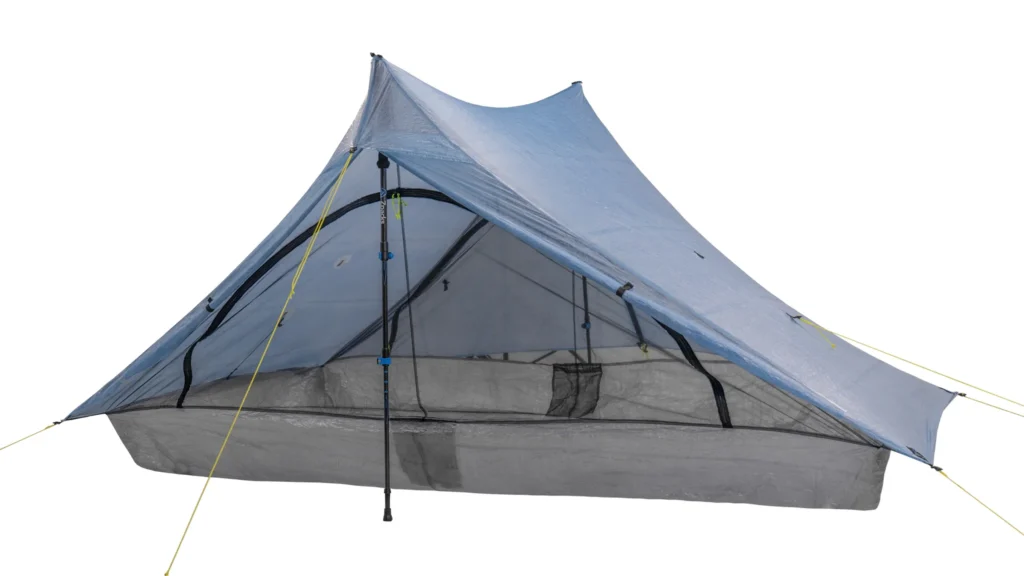
Zpacks Duplex Zip
Price: $729
Listed Weight: 1 lb. 4.4 oz.
Measured Weight: 1 lb. 4.5 oz.
Dimensions (LxWxH): 90 x 45 x 48 in.
Note: Weights do not include poles or stakes
Pros
- Ultralight
- Durable fabrics
- Packs small
- Excellent weather protection
- Great ventilation
- Spacious
- Easy to pitch
- Smooth zippers
- Large doors & vestibules
Cons
- Expensive
- Interior condensation
- Non-freestanding design
- Handle with care
- Difficult to shake out
- Pockets only okay
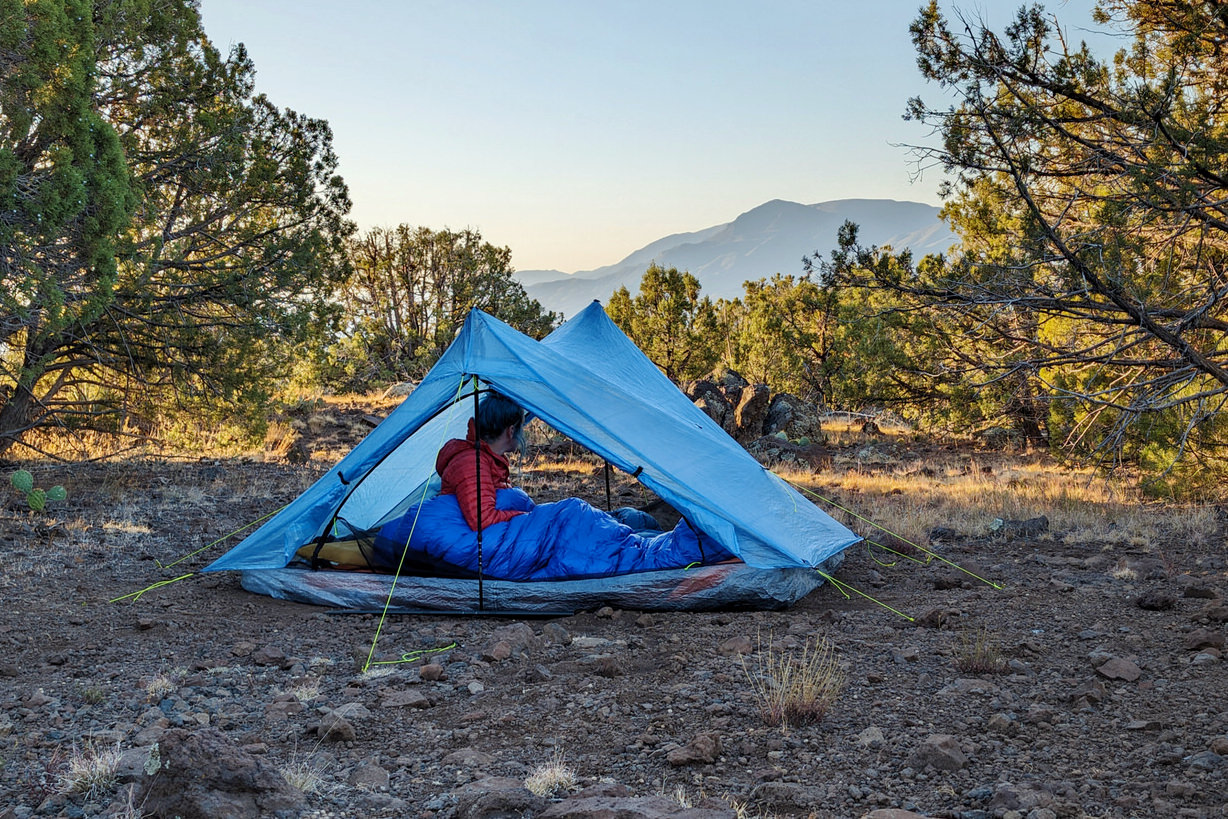
Comfort
The Zpacks Duplex Zip tent is a sleek and comfortable no-frills tent made with quality materials and attention to detail. The fairly spacious interior has plenty of headroom for folks up to six feet tall, so it’s easy to move around inside without bumping into your partner. The symmetrical design means no fighting for space- both occupants can sleep in the same or opposite directions and get equal space. Two small mesh pockets are good for holding handheld essentials like chapstick, lighter, and phone. And the floating bathtub floor, combined with the full mesh surrounding it, helps keep interior condensation at bay, so you’ll wake up dry and cozy most mornings.
The rainfly zippers have been smooth and easy to use since the first time we set up this tent, adding to its comfort level. They can be operated with one hand even when the pitch is taught. There are four total rainfly doors, and we love that each can be rolled up independently depending on conditions, and the doors stay up easily thanks to convenient magnetic toggles (a nice touch). Two large interior doors and two average-sized vestibules offer easy access and extra gear storage. Entering and exiting a Zpacks tent has never been easier.
But the Duplex Zip’s design won’t hit the nail on the head for everyone. Single-wall tents like this struggle with interior condensation in humid, wet, and cold conditions. It’s not always that bad, but you might need to be careful not to brush up against the interior wall of your tent. Also, The floor design of the Duplex Zip is plenty wide for regular-width sleeping pads, but it’s a bit too narrow for wide sleeping pads. So the space might feel tighter for two, depending on your kit – we also like the roomy Triplex Zip for pairs who want more space. Additionally, the Duplex Zip isn’t as easy to remove dirt and debris from since you can’t shake it out like a freestanding model. And, the small pockets are pretty basic – we find the pockets get lost under our sleeping pads at times, and anything in them is at risk of getting squished. But none of these gripes are deal breakers – this tent is a comfy ultralight choice for backpackers from May through October in most terrain.
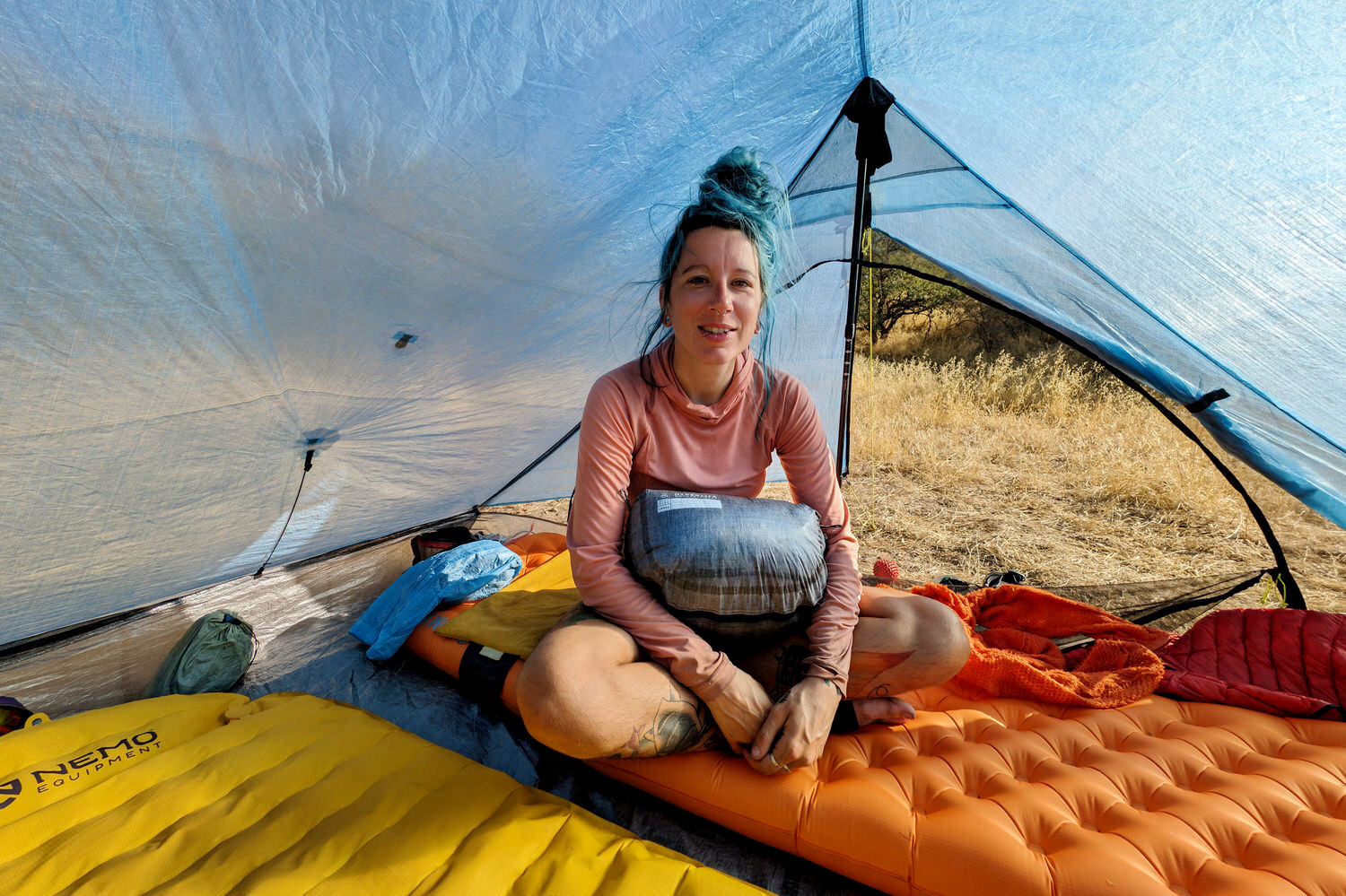
Weight & Packability
The Zpacks Duplex Zip is a great choice for ultralight backpackers. Weighing just 1 pound, 4.4 ounces – only a bit heavier than the standard Duplex Classic version – the Zip is among the lightest two-person tents available anywhere. Its non-freestanding design is the key: the Zip eliminates bulky and heavy tent poles to cut weight and uses trekking poles or carbon fiber tent poles instead. The mesh inner, lightweight but durable components, and an exterior made of super light Dyneema Composite Fabric (DCF) make this tent easy to carry whether you’re taking on 20-mile days or thousands of feet of ascent and descent.
The ultralight Dyneema Composite Fabric contributes to its lightness and durability, making the tent surprisingly rugged for its weight. Like other Zpack models, the tent also packs down fairly small: its stuff sack is only 7 inches by 13 inches, so it fits into most backpacks without taking up much space.
But ultralight designs come with trade-offs. Since it’s non-freestanding, the Duplex Zip can be challenging to set up in rocky or hard-packed terrain where tent stakes might not secure properly. This makes campsite selection a little trickier, and you may need to use non-traditional elements like rocks and logs to help tension your guy lines. And Dyneema, while incredibly light, doesn’t pack down as easily or as small as silnylon. In fact, we don’t recommend stuffing this tent since the material can break down faster that way. Instead, we recommend folding and rolling it. This tent’s slightly larger packed size might be a drawback for folks who want to optimize every inch of pack space, but you’ll be hard-pressed to beat its weight.
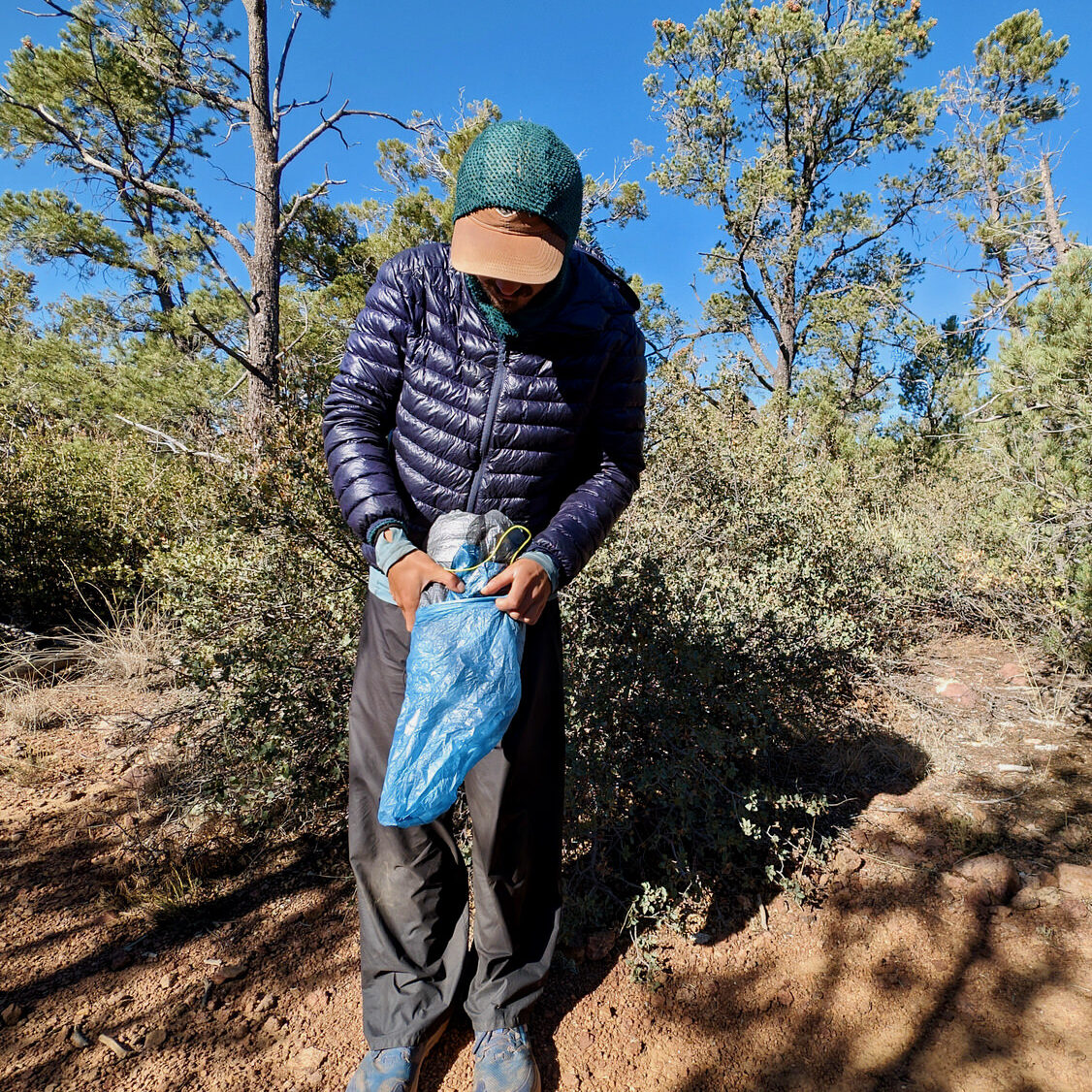
Weather Resistance
When it comes to weather resistance, the Duplex Zip is excellent. Its naturally waterproof DCF exterior and floor, combined with the zippered rainfly, make this tent a top performer in rain and light snow. DCF doesn’t sag in cold or wet weather like silnylon and silpoly, so your pitch will stay taut if it’s staked down properly. While we like the tiebacks of the Duplex Classic version – and have rarely had issues with water getting in – the convenience of zipper doors in nasty weather is nice. If you’re heading into all weather conditions, a couple of extra ounces for waterproof zippers are worth it. And thanks to factory-taped seams and an 8-inch-tall bathtub floor, you’ll stay cozy and dry in downpours and avoid splashback from puddles. This unique design also includes extra wall guyout points to secure your tent to the ground, so it’s a reliable shelter in strong winds as well.
This tent handles condensation pretty well, too. The four doors can be rolled up individually with magnetic tiebacks. This allows you to control the airflow depending on wind direction, and you can keep the doors open even in light rain or a dripping wet forest. Peak vents above the storm doors and the floating bathtub floor allow for additional airflow when the doors are closed as well.
The Duplex Zip is robust in bad weather but has some limitations. The vents are excellent, but you’ll still deal with interior condensation eventually: it’s simply a reality of single-wall tents, especially in humidity or freezing temps. We recommend leaving the vestibule doors at least partially open when possible to cut down on interior condensation. Remember that this tent’s weatherproofing depends on how well it’s secured to the ground, so you’ll want to carefully tension all guy lines and drive in all stakes for the best results before the skies open up. This can present a challenge in rocky or uneven terrain, so we like to give ourselves ample time to select an ideal campsite. Also, you’ll want to make sure you’ve got tent poles or trekking poles that can extend to the full 48-inch peak height to achieve the strongest pitch.
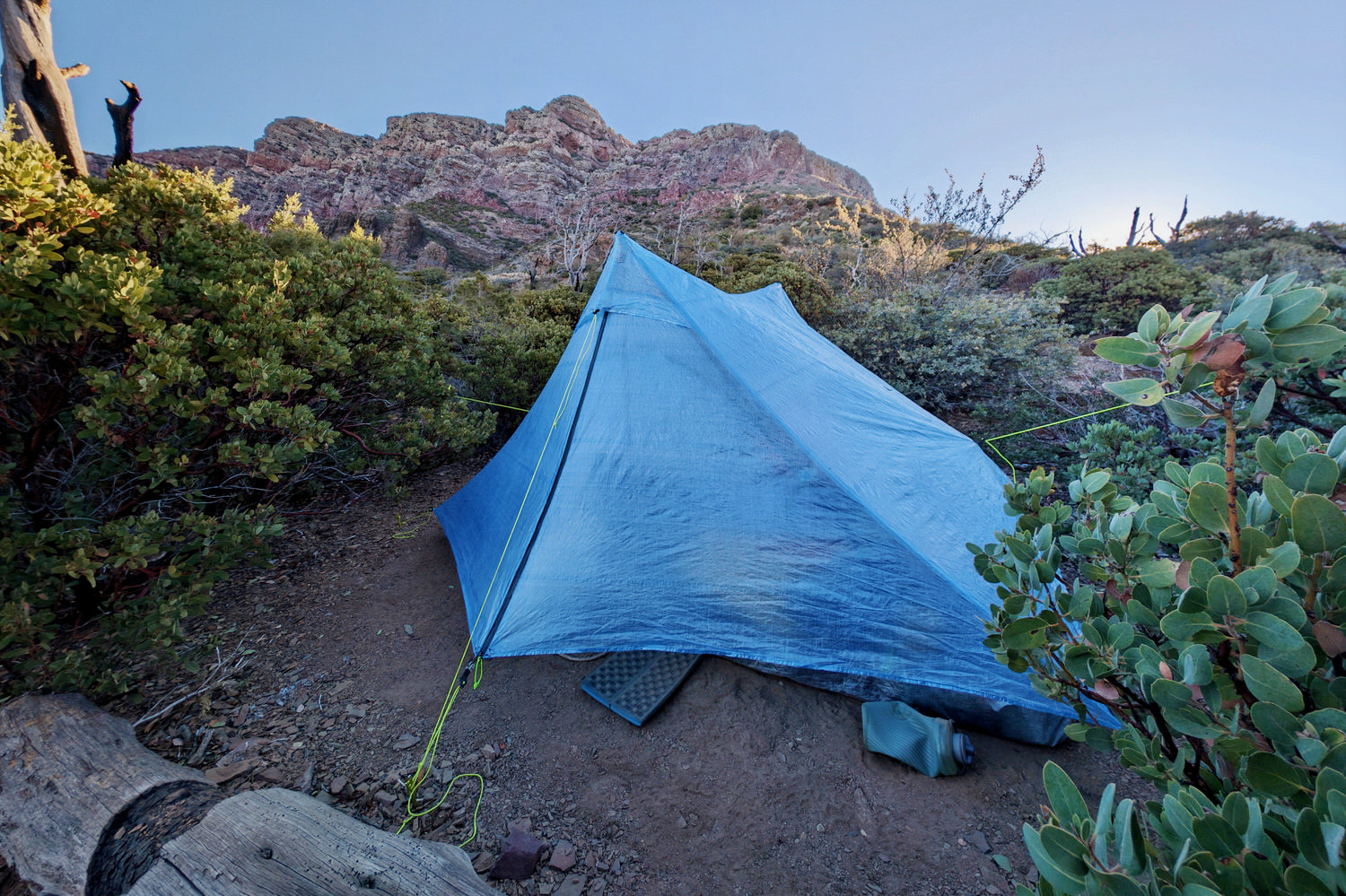
Ease of Setup
Not all non-freestanding tents are created equal: some are more finicky to pitch than others, but we like the Duplex Zip because it’s so simple. The symmetrical design makes pitching the Zip straightforward, even on rough terrain or when stakes aren’t perfectly placed. The Zip’s wide footprint means you’ll need to find a spacious, flat, and open campsite for the best pitch. It relies on six stakes, with four at the corners and 2 at the doors – as long as you’ve squared off the four main stakes well, the following steps are easy, and you won’t need to readjust angles or fiddle with stake placement too much. With this model, you can add up to four more stakes via guyout points on the fly to further secure it, depending on the forecast.
For beginners, Zpacks provides a helpful tutorial video as well as solid instructions, but it only takes a few trial runs to master the setup process. The learning curve is short, and most users quickly get the hang of it after a few tries. After 3-5 practice runs, you’ll find it only takes around 3 minutes to set up the Duplex Zip in most conditions.
However, the Duplex Zip will feel more cumbersome to pitch if you’re used to freestanding tents. Finding a flat, wide campsite for all six stakes can sometimes take extra time. Additionally, hard or rocky ground can make it difficult to drive tent stakes deep enough. Tensioning the tent is crucial for proper stability, and a rushed or uneven setup can lead to sagging or poor protection. And, while most trekking poles extend to 48 inches or beyond, check your pole height ahead of time: if your poles are too short, you’ll need to purchase a separate tent pole. Practice is the most important thing before heading into the backcountry, so consider taking the time in your backyard to perfect your pitch.
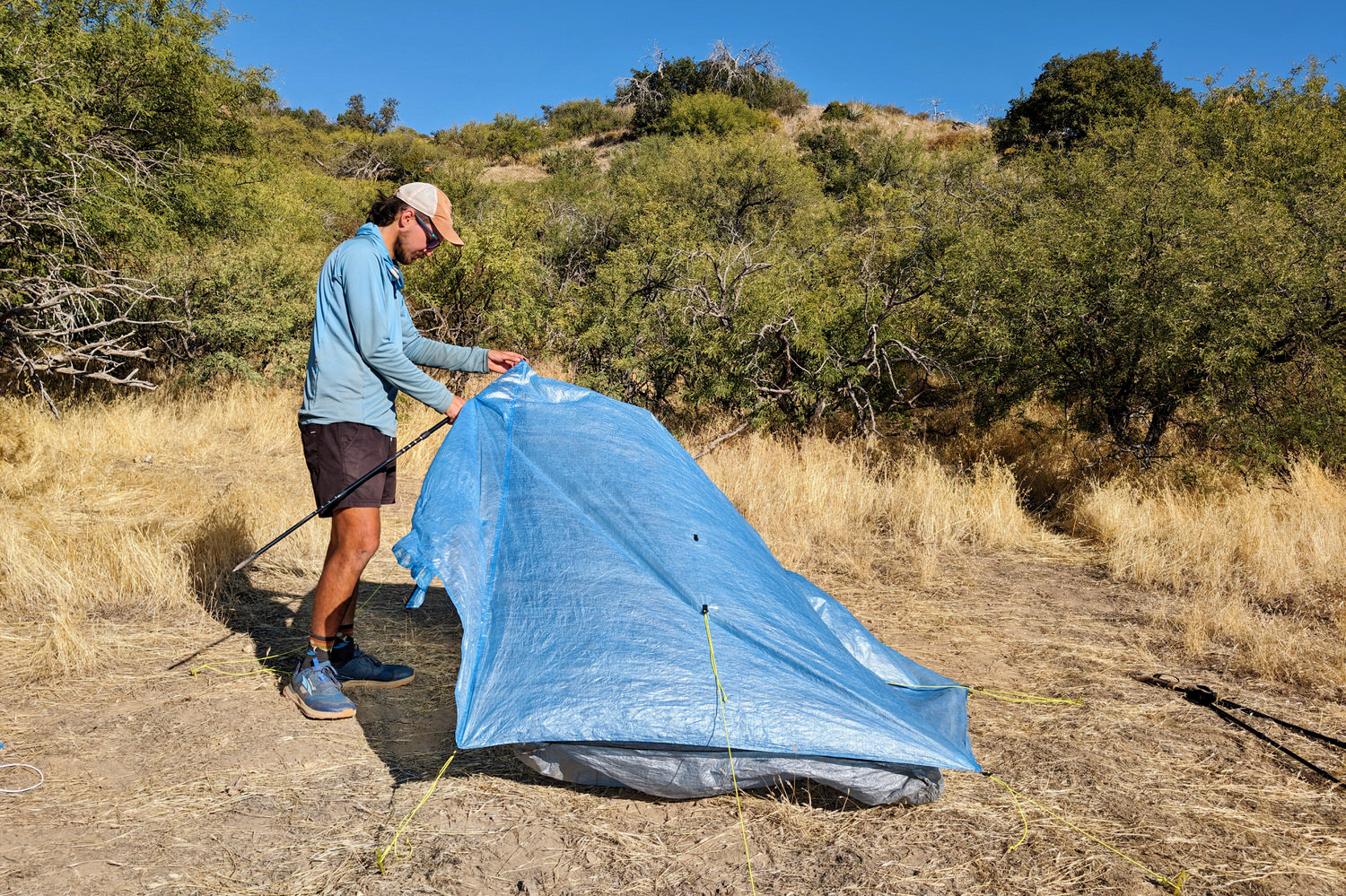
Durability
The Zpacks Duplex Zip tent is a reliable shelter built to last thousands of miles. Its durability boils down to high-quality Dyneema Composite Fabric (DCF) for the canopy and even thicker DCF for the floor. DCF offers top-tier tensile strength, so it can handle the wear and tear of backcountry conditions, from harsh weather to rocky terrain, while keeping weight very low. During our 500-mile test hike across the rugged Sonoran Desert, the Duplex Zip showed no signs of major damage despite the endless cacti, rock-filled campsites, and shoulder-season storms. Zpacks include thoughtful features like waterproof zippers, burly but lightweight components, and even DCF repair patches for quick fixes. We love that replacement zipper sliders are also included, making for easy field repairs – although we’ve yet to need them. If you’re worried about the floor of your tent, you could buy a footprint for additional durability, but we’ve never seen the need for one since the DCF is robust and impressively resistant to punctures and tears.
That said, some factors will impact the Zip’s durability in the long run. The tent’s non-freestanding design requires proper staking, which can be challenging on hard or rocky ground, so you may need to get creative with logs or rocks if the stakes don’t work. You’ll need to find campsites that are fairly flat and free of debris to preserve the materials, which makes finding the ideal spot a bit of a process sometimes, and you’ll want to clear potential hazards before laying out the tent. And, like any single-wall tent, interior condensation can form, negatively affecting the tent material over time if it isn’t dried before storage. Still, we’ve found these issues to be minor. The Duplex Zip is a strong contender for anyone who wants an ultralight tent that is comfy and durable.
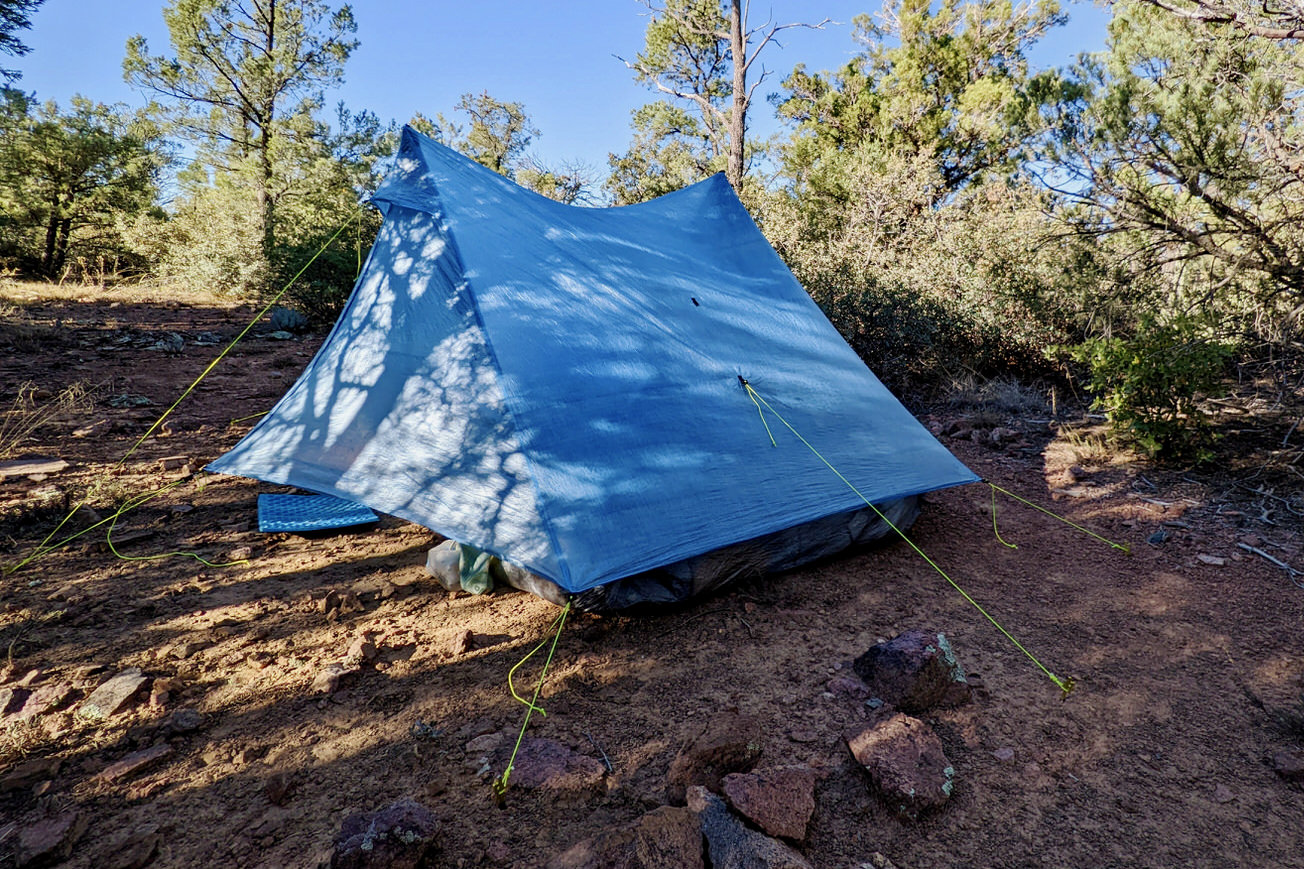
Duplex Zip vs. Duplex Classic VS. Duplex Lite
So you’re interested in picking up a Zpacks Duplex, but now you need to decide which version to buy. Well, we’ve extensively tested all three versions and can give you some insight.
The Duplex Lite is really more of a one-person tent. It’s the lightest of the three options but also the narrowest. We like the Lite for solo use (having two doors/vestibules is great in a 1P tent), but if you plan on sleeping with a partner, we’d recommend one of the other Duplex or Triplex models for additional space.
The Duplex Classic and Triplex Classic remain our top recommendations for most ultralight backpackers under the most common conditions. The only major difference with these tents is that the doors use metal hooks and toggles instead of zippers, but we’ve found that they perform well over thousands of miles of testing. As an added bonus, the Classic models cost a bit less, weigh a bit less, are a little easier to pitch on uneven ground, and have fewer components that could fail.
The Duplex Zip and Triplex Zip are the ultralight tents we recommend to hikers who want the most stormworthy option. The zipper doors are nice for when the skies are opening, and you’ll want to have your storm doors down most of the time. The zippers make entering and exiting the tent easier in consistently rainy conditions. The added peak vents and magnetic door toggles are also a nice touch, though we have not found them to be essential.
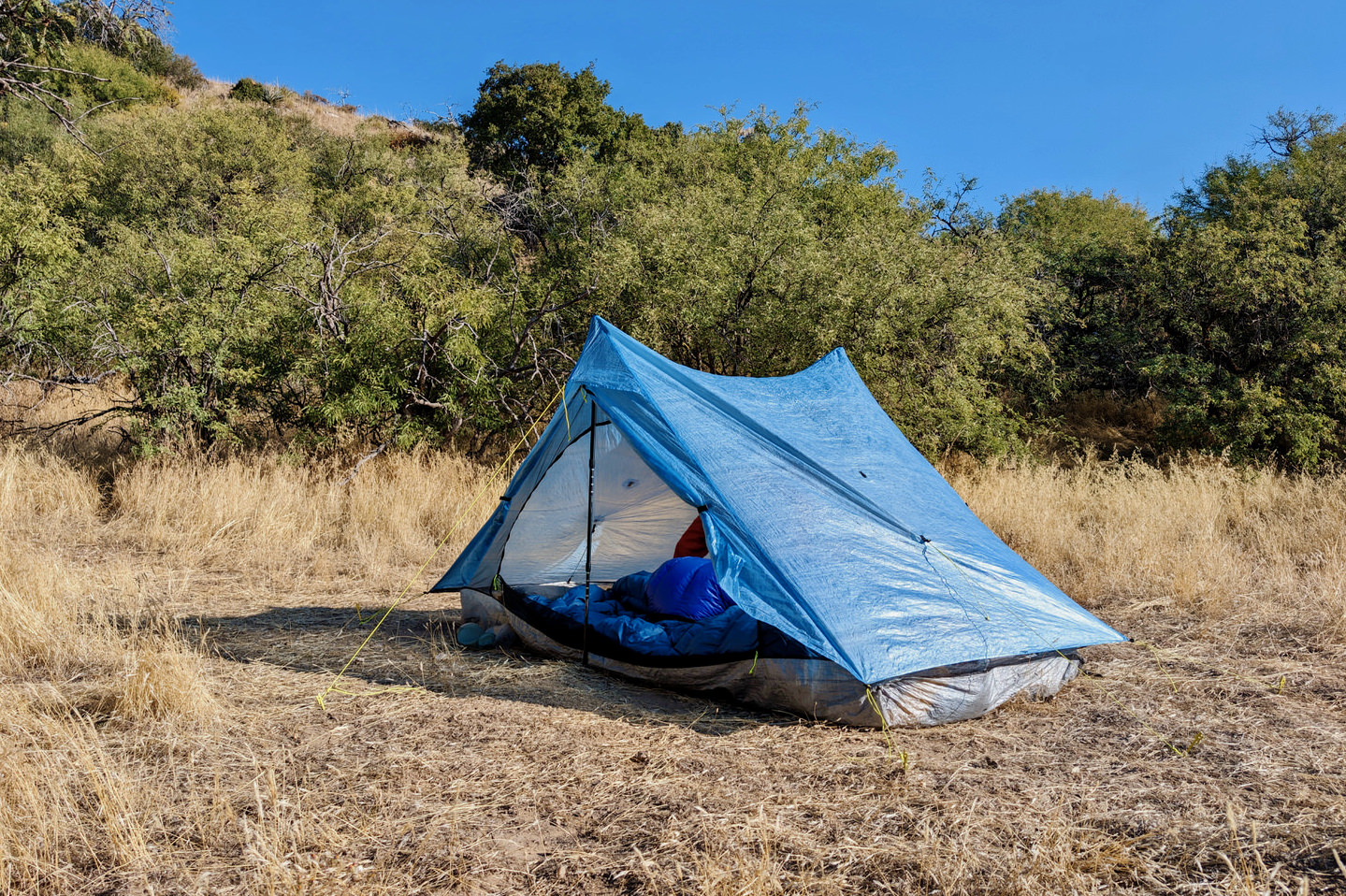
Should You Buy the Zpacks Duplex Zip?
The Zpacks Duplex Zip is a high-performance, spacious, and weather-resistant shelter. If you’re an ultralight backpacker, thru-hiker, or minimalist pair, this tent is one of the highest-quality shelters around. The addition of rainfly zippers makes this Duplex even more weather-resistant than the Duplex Classic. If you’re heading into shoulder season with low temps, lots of rain, and even light snow, the Zip is one of our top ultralight choices. This tent is also excellent for summer outings, making it a great all-around ultralight tent choice.
However, this tent won’t be the best fit for casual campers. The non-freestanding design requires more attention and focus to pitch compared to freestanding tents. The lack of comfort features like big pockets, internal door tiebacks, and large vestibules might be a turn-off for some campers who might not mind carrying a bit more weight for increased livability. Also, this tent is very expensive, so its high price point might deter budget-conscious buyers.
All in all, the Duplex Zip is one of the highest-quality ultralight tents on the market. It’s one of our top choices for experienced adventurers who need performance, weather resistance, and weight savings in a shelter that will last for many years of hard use.
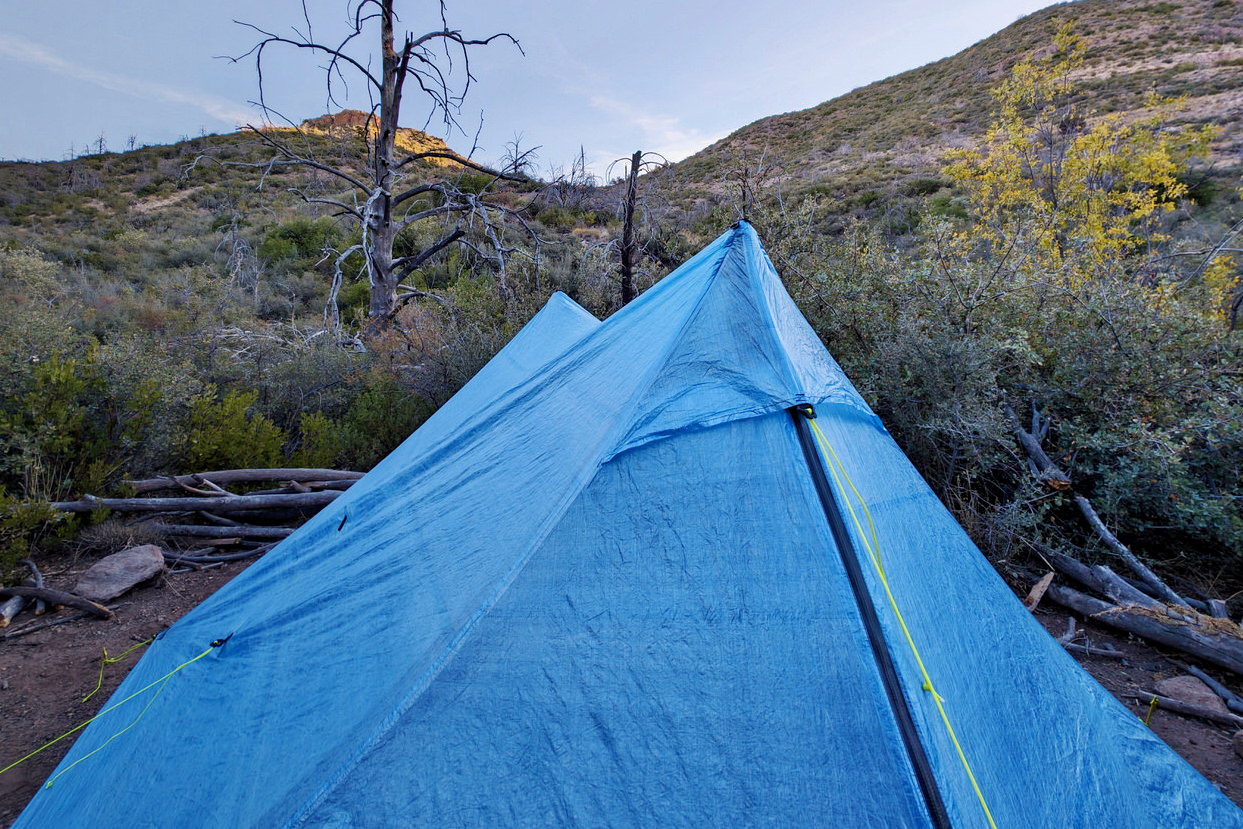
What Other Backpacking Tents Should You Consider?
ZPacks Duplex Classic Review: If the price point or extra ounces of the Zip aren’t hitting the mark, the Duplex standard is a great option and remains our top Duplex tent recommendation for most backpackers. It’s almost identical to the Zip, but uses tiebacks on the outer fly instead of zippers. This makes it slightly less storm-worthy, but it’s a bit more affordable, easier to pitch on uneven ground, and has fewer components that can break.
Zpacks Triplex Classic Review: Hiking partners who want more interior space will love the increased roominess of the Triplex. This is a stellar option for pairs who want room to accommodate wide sleeping pads, storing gear inside, or room for their dog. The Triplex also comes in a Zip version as well. You’ll pay more for the Triplex, and it’s a tad heavier, but many hiking partners find these tradeoffs well worth it for the extra space.
Big Agnes Tiger Wall UL2 Review: The Big Agnes Tiger Wall UL2 is a more traditional semi-freestanding tent with an easier setup than non-freestanding tents. Like the Duplex Zip, this one is still impressively lightweight, roomy, and packable. It’s more affordable, has tons of pockets, and has larger vestibules – although it weighs almost twice as much as the Duplex Zip.
Durston X-Mid 2: The Durston X-Mid 2 shares the Zpacks Duplex Zip’s non-freestanding design and spacious interior, including small pockets and two entry points. What sets it apart is its low price – it’s less than half the cost. The X-Mid offers solid storm resistance as well, but its setup is less intuitive, its interior is less comfortable for two people, and it weighs quite a bit more.


